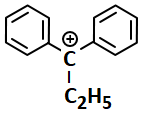Ph-CH=CH-COOH
The IUPAC name is:
1. 3-Phenyl prop-2-enoic acid
2. 3-Phenol prop-1-enoic acid
3. 3-Carboxy-prop-1-ene benzene
4. But-2-enoic acid
The IUPAC name ![]() iS'
iS'
1. Chloromethylbenzene
2. Chlorophenylmethane
3. (1) and (2) both
4. None of the above
The IUPAC name of the following compound is:
(1) 4-Bromo-3-cyanophenol
(2) 2-Bromo-5-hydroxybenzonitrile
(3) 2-cyano-4-hydroxybromobenzene
(4) 6-Bromo-3-hydroxybenzonitrile
The silver sulphate solution is used to separate:
1. nitrate and bromide
2. nitrate and chlorate
3. bromide and iodide
4. nitrate and nitrite
Soda extract is prepared by-
1. Fusing soda and mixture of hydrocarbons, and then extracted with water
2. Dissolving NaHCO3 and mixture of hydrocarbons in dil. HCl
3. Boiling Na2CO3 and mixture of hydrocarbons in dil. HCl
4. Boiling Na2CO3 and mixture of hydrocarbons in distilled water
The most stable carbocation among the following is:
| 1. |  |
2. |  |
| 3. |  |
4. |  |
The compound which forms one monochloro product when treated with chlorine is:
(1) n-pentane
(2) isopentane
(3) neo-pentane
(4) None of these
Among the following anions (a) CH3, (b) NH2, (c) OH-, (d) F-, the order of basicity is:
1. a > b > c > d
2. b > a > c > d
3. c > b > a > d
4. c > a > b > d
The electromeric effect in organic compounds is a
1. Temporary effect
2. Permanent effect
3. Electromeric effect is only observed in inorganic molecules
4. None of the above
The arrangement in decreasing order of stability of H3, H5,(CH3)2H and (CH3)3 free radicals is-
1. H3 > H5 > (CH3)2H > (CH3)3
2. (CH3)3 > (CH3)2H > H5 > H3
3. H5 > H3 > (CH3)2H > (CH3)3
4. (CH3)3 > (CH3)2H > H3 >H5







